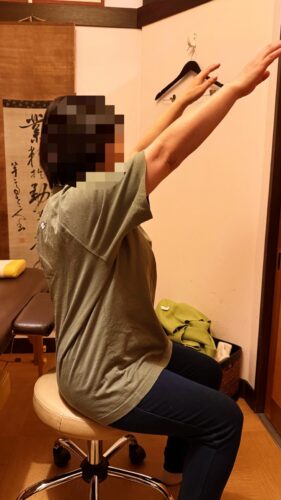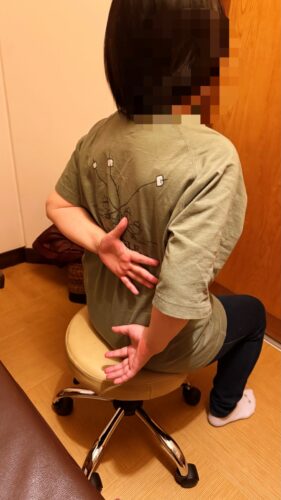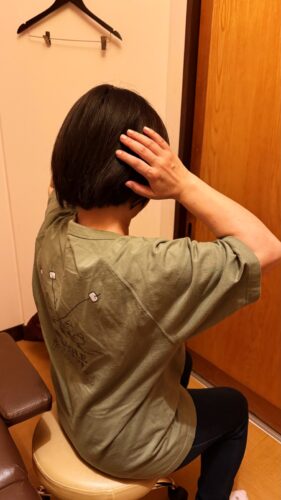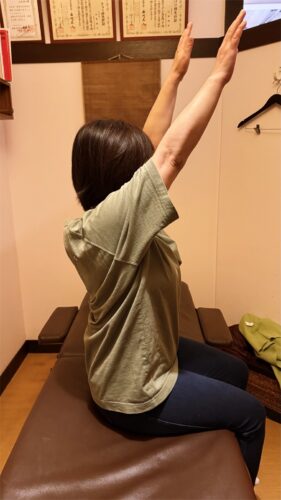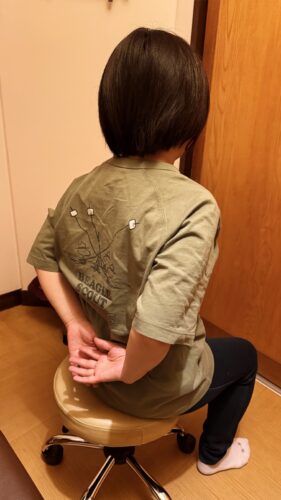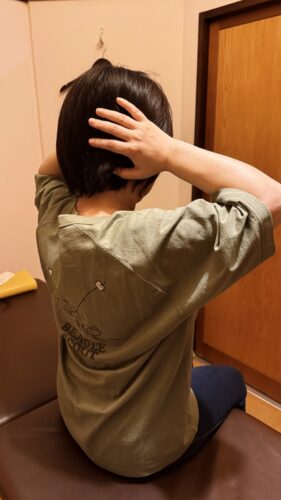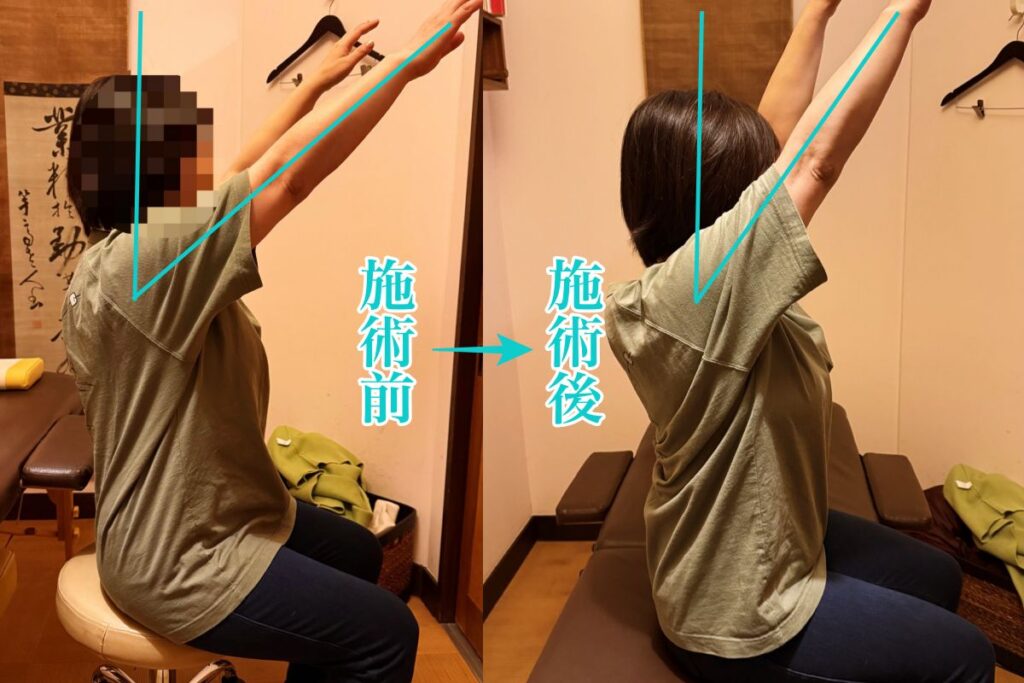
鍼灸担当の山本浩士です。
このコラムでも何度か書いている「肩関節周囲炎」つまり「五十肩」ですが、また書いてみます。
昨年(2024年)10月後半に寝違えのようになってから、痛みが背中へ広がり、徐々に肩が痛くなって動かせなくなったという女性が来院。
近くの整形外科へ行き、レントゲンなどの検査をして「肩関節周囲炎」と診断されました。
医師にヒアルロン酸を注射され、理学療法士が肩周りの筋肉群を揉みほぐすという治療を続けているそうです。
それで改善しましたか?と聞くと、あまり変わりませんと小声で言われました。
私は、ヒアルロン酸が悪いとも、局部マッサージや強度ストレッチ療法が悪いとも言いません。
それらが良いこともありますが、良い結果が出ないこともまた多いのです。
確かに、肩関節に炎症があって、周囲の筋肉が硬くなって動きを阻害していると思います。
といって、そこだけの着目していても治らないことが多いのもまた事実です。
時々、ぎっくり腰で来る男性がおられます。
都内にある大学医学部の外科の教授です。
私が、大学病院にたくさん先生がいるでしょ!!
こういうと、
私は整形外科を信じていない。後輩にもたくさん整形外科医がいるが、彼らは痛み止めの注射はするがこの腰痛を治すことはできない。
私は鍼灸の効果を実感して信じている。
そう笑って言われます。
実際、まともに歩いて来れない状態で来院され、帰る時には普通に歩いて帰られます。
何が良いとか悪いという話ではなく、体に対しての認識、着目点を少し変えていくだけで、同じことをしても結果が変わることがあります。
今まで学んだ知識、経験値、医学常識という枠の中だけにいると、その外にある世界になかなか気がつけません。
これらは思い込みが作っていますね。
ですから、視点を変えることができれば、今まで見えなかった部分が見えてくるようになり、意外な解決策が見つかることもあります。
逆に、東洋医学、漢方医学だけを見ていてもダメです。
医学に古今東西はなく、ただ目の前の生きた体から真実を学ぶ、これが恩師(病理学教授)の教えでした。
さて、まず肩が痛いというこの女性に施術を開始です。
まずは、現状の確認をしました。
椅子に座ってもらったまま、上肢を軽く持って痛みの出にくい範囲で動かします。
牽引を基本に、屈曲、伸展、内外旋、内外転、回内外といった物理的な動作をします。
理学療法では構成運動というようですが、体というのは部分と全体が連結しています。
東洋医学では経絡脈と経筋をイメージすると良いですね。
手首を軽く動かすだけでも、肩関節まで連動していきます。
和氣香風では、こうした連動を主体として徒手療法をおこないます。
5分ほど施術をしたのち、ご自身で動作確認をしてもらいます。
可動域は変わりましたが、まだ痛みが強いようです。
このかたは、肩関節が痛くなる前にまず寝違えのような痛みが首に出たと言いました。
頸椎周囲を触診すると、筋肉がかなり硬くなっていて、それは腰の方まで続いていました。
そんな時「そういえば、首が痛くなるもっと前に、ぎっくり腰のような痛みで悩んだ」と教えてくれました。
その腰痛は、いつの間にか痛みが無くなったので、何もせずにそのまま過ごしていたそうです。
この話から考えると「腰痛→首の痛み→背中の痛み→肩の痛み→五十肩」こういう流れが見えてきます。
この方は、過去にもぎっくり腰などで来院していましたので、元々腰に爆弾を抱えているのです。
股関節と肩関節は離れていますが、骨や筋肉などで繋がっています。
だから歩く時に、自然と腕も振られますね。
ということで、股関節と腰椎の動きを改善させる処置を入れました。
そうすると、さっきまであった肩関節内部の痛みが和らいだと言います。
肩は触っていませんが、足を動かして股関節と腰椎を動かしただけで、肩関節に影響が出るということです。
もう一度椅子に座ってもらい、夾脊(きょうせき)と呼ばれる、脊椎の際に鍼を打っていきました。
これで治療は終了です。
もういちど、動作確認をしました。
まだまだ改善の余地はありますが、かなり変わりました。動作痛もかなり減ったと喜ばれました。
- また痛みが戻ることはあるが、ちゃんと治っていくこと。
- 前方から腕を上げることはすぐに問題なくなっても、ブラジャーのホックを止めるような腕を後ろに回す動作はもう少し時間がかかること。
これらのポイントを伝えた上で、セルフケアの気功も伝えて今日の治療を終了しました。
- ヒアルロン酸を注射しなければならない。
- 筋肉が硬くなったところを強く揉まなければならない。
- 痛みを我慢してきついストレッチをしなければならない。
- 手術以外に治す方法はない。
- 太い鍼をたくさん刺さなければいけない。
- 低周波治療をしなければならない。
こういうことは、よく病院や鍼灸院で言われる方が多いようですが、実際にはそんなことは無いと和氣香風では考えています。
この方には、一本の銀鍼だけを使い、いくつかの部位に鍼を刺して抜くという技術を繰り返しました。
鍼が刺さる深度は1ミリー2ミリ程度。
使った鍼の太さは0.21ミリサイズ。
鍼治療の時間は5分程度。
痛みが深いところにあれば、深くに刺すこともありますが、相手に痛みが出ないように繊細に技術を使っていきます。
あるいは、1ミリ程度鍼を刺したままにして、相手の腕を動かす「運動鍼」もかなり効果的です。
関節痛でお悩みの方はお気軽にご相談ください。
Treatment for Persistent Frozen Shoulder
I have written about frozen shoulder (also known as adhesive capsulitis) multiple times in this column, but I’d like to revisit the topic.
In late October 2024, a woman visited my clinic. She initially experienced what felt like a stiff neck, but the pain spread to her back, and over time, her shoulder became painful and immobile.
She had already visited a nearby orthopedic clinic, where X-rays and other tests confirmed the diagnosis: adhesive capsulitis.
Her doctor administered hyaluronic acid injections, and a physical therapist had been massaging her shoulder muscles as part of her ongoing treatment.
When I asked if she had improved, she quietly replied,
“Not really.”
I am not saying that hyaluronic acid injections, localized massage, or intensive stretching therapies are inherently bad. These methods can be beneficial in some cases, but in many others, they do not lead to significant improvements.
It is true that inflammation in the shoulder joint can cause surrounding muscles to tighten and restrict movement. However, focusing only on the affected area often fails to bring lasting relief.
A Professor’s Perspective on Pain Treatment
From time to time, a university professor of surgery visits my clinic with acute lower back pain (lumbago).
Since he works at a prestigious medical school in Tokyo, I once asked him,
“You have so many doctors at your hospital, don’t you?”
He laughed and replied,
“I don’t trust orthopedic treatments. Even though many of my colleagues are orthopedic surgeons, all they do is give painkiller injections―they can’t actually cure this type of back pain. I believe in acupuncture because I’ve experienced its effects firsthand.”
He often arrives barely able to walk, but by the time he leaves, he is walking normally.
Changing Perspectives to See New Solutions
This is not about which method is right or wrong. Rather, shifting one’s perception of the body can lead to completely different treatment outcomes―even when using the same techniques.
If you limit yourself to conventional medical knowledge and experience, you may never notice the possibilities beyond those boundaries. These preconceived notions shape our thinking.
However, when you shift your perspective, you start to see what was previously invisible, and unexpected solutions emerge.
At the same time, focusing solely on Eastern medicine or herbal medicine is not enough.
My pathology professor once taught me:
“There is no distinction between East and West in medicine. The only truth lies in what we learn directly from the living body in front of us.”
Beginning Treatment for Shoulder Pain
I began treatment for this woman’s shoulder pain by first assessing her current condition.
While she remained seated, I gently supported her upper limb and moved it within a range that minimized discomfort. Using traction as the foundation, I guided her through flexion, extension, internal and external rotation, adduction, abduction, and pronation/supination.
In physical therapy, this is known as “component motion,” but the body functions as an interconnected whole rather than isolated parts. From the perspective of Eastern medicine, it helps to visualize the meridians (jing-luo) and muscular pathways (jing-jin).
Even the slightest movement of the wrist creates a ripple effect that reaches the shoulder joint. At Kakikofu, we base our manual therapy on these natural body connections.
After about five minutes of treatment, I asked her to check her movement. While her range of motion had improved, she still experienced significant pain.
She had initially mentioned that her shoulder pain was preceded by a strained-neck sensation. When I palpated her cervical spine area, I found considerable muscle stiffness, extending all the way to her lower back.
At that moment, she recalled, “Come to think of it, before my neck pain started, I had suffered from lower back pain, almost like a sudden strain.”
That lower back pain had disappeared on its own over time, so she hadn’t taken any action to address it.
From this history, a pattern emerged:
Lower back pain → Neck pain → Back pain → Shoulder pain → Frozen shoulder
She had visited my clinic in the past for acute lower back pain, which suggested that her lower back was a persistent weak point.
Although the hip and shoulder joints are far apart, they are connected through the skeletal and muscular systems. This is why our arms naturally swing when we walk.
With this in mind, I incorporated techniques to improve the mobility of her hip joint and lumbar spine.
As a result, she noticed that the deep pain inside her shoulder joint had subsided―despite the fact that I had not touched her shoulder at all. Simply mobilizing her hip and lumbar spine had influenced her shoulder.
To conclude the session, I had her sit again and applied acupuncture along the Kyoseki/Jiaji (夾脊) points along the spinal column.
With this, the treatment was complete.
I then asked her to check her movement once more.
Significant Improvement and Key Takeaways
While there was still room for further improvement, her condition had changed considerably. She was delighted to find that her movement-related pain had significantly decreased.
I explained two key points to her:
•The pain might return at times, but with proper treatment, it would gradually heal.
•Raising her arm forward would soon be problem-free, but movements that involve reaching behind her back―such as fastening a bra―would take a little more time.
After sharing these insights, I also taught her a self-care qigong exercise to support her recovery. With that, the session came to an end.
Misconceptions About Treatment
Many people hear statements like these from hospitals or acupuncture clinics:
•“You must get hyaluronic acid injections.”
•“You need to aggressively massage hardened muscles.”
•“You must endure intense stretching, even if it hurts.”
•“Surgery is the only option.”
•“Thick needles must be inserted in large numbers.”
•“Low-frequency therapy is necessary.”
At Kakikofu, we believe that such approaches are not always necessary.
A Gentle Yet Effective Acupuncture Approach
For this patient, I used just one silver needle, applying and removing it at various points with precise technique.
•Needle thickness: 0.21 mm
•Insertion depth: 1-2 mm
•Acupuncture Treatment time: About 5 minutes
If the pain is deep-seated, deeper needle insertion may be required, but I always apply techniques with utmost delicacy to avoid causing discomfort.
Another highly effective method is “motion acupuncture”, where a needle is inserted about 1 mm and left in place while the patient moves their arm.
For those struggling with joint pain, feel free to reach out for a consultation.
